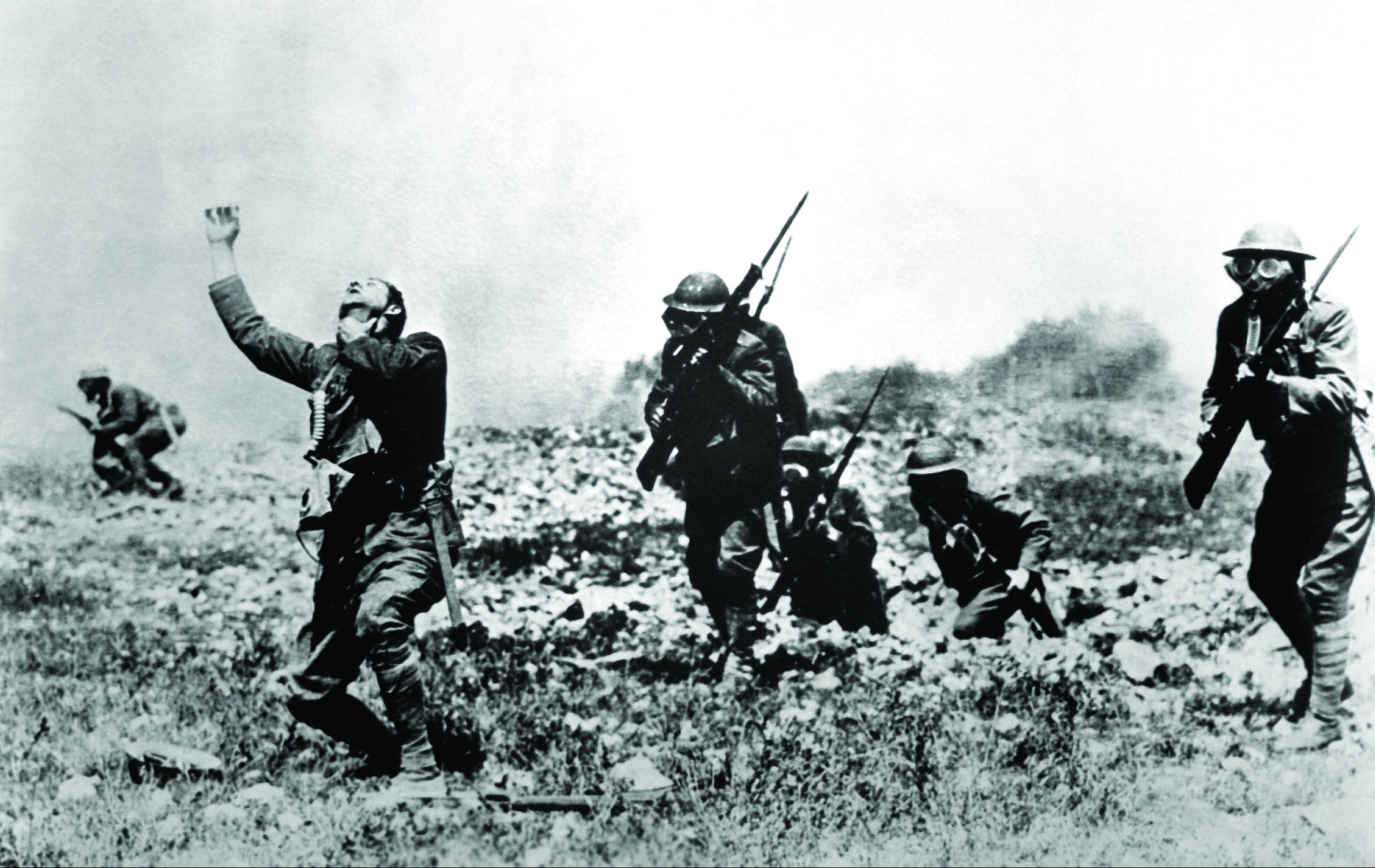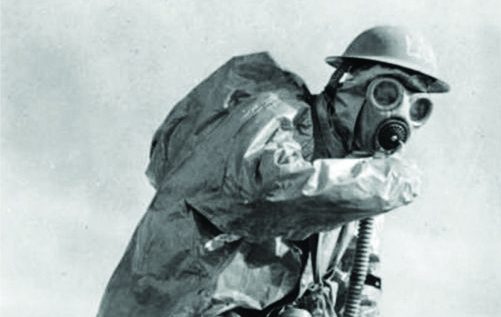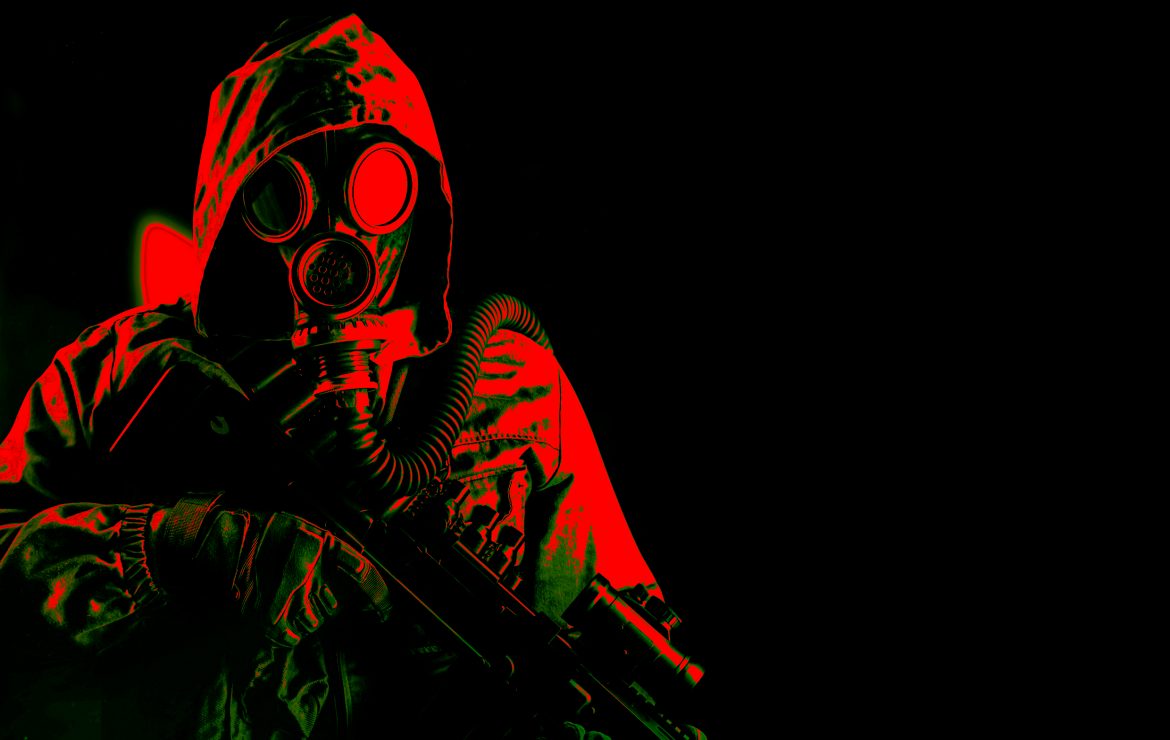The prevention of chemical warfare agents has been an important focus of military interest throughout history. The manufacture of protective clothing has evolved with other technical advances in materials science, manufacturing, and military technology. The use of protective clothing from chemical agents used in the First World War began from rubber, where the soldier’s body is completely covered with gloves and shoes except for the face that is protected by the mask. These clothes are usually described as impermeable, meaning that chemical agents cannot penetrate, and at the same time with time, the sweat that is secreted from the skin cannot penetrate outside, so wearing this type of clothing for a longer period is uncomfortable, especially in hot climates, and it can tear and wear easily in such difficult conditions
In addition, wearing chemical protective clothing during military operations limits a soldier’s skill, mobility, control, communication, and stamina. Historically, many field studies have been conducted to determine the extent of the impact of chemically contaminated protective clothing on the combat mission and the physiological and psychological effects on the combatant. The result was that high ambient temperatures and high workloads were particularly detrimental to endurance. To overcome all these challenges, realistic training is essential to maintain performance on a chemically contaminated battlefield. Despite the fact that the world’s leading countries have eliminated most of their stockpiles of chemical weapons, the threat of their use remains real. The arsenals of some third world countries still have large stocks of chemical warfare agents and are actively used during combat in armed conflicts or in cases of chemical terrorism.
Stress-free protection
The risk of being attacked by chemical agents is of concern to military commanders in action, although their use may seem unexpected, due to the prohibition of such weapons by international treaties. There is undoubtedly good reason for this concern, because if the forces are not properly prepared and ill-equipped, it could lead to heavy losses and a failure of the operation. Therefore, this requires adopting the necessary measures to prepare for protection from chemical warfare agents, perhaps the most important of which is individual protection equipment. This equipment can be huge, heavy and cumbersome, and often has a negative impact on the ability of soldiers to perform their duties and limit their mobility and performance. In the event of a chemical attack, each soldier must respond immediately, wearing the necessary protective equipment to protect against exposure, meaning that he must constantly wear a gas mask and a protective suit against special chemicals. It is worn over normal combat clothing. It can be stressful, uncomfortable, and sweaty, especially if the protective suits are tightly closed and not breathing, which can lead to an overheating of the body. In conditions of high ambient temperatures, the possibility of heat stroke, dehydration and other serious problems increases (even without the high physical activity of soldiers in battle). The performance of the simplest tasks in such a suit becomes complicated, and stamina rapidly decreases.
Several practical human factor concerns have been identified when wearing such protective suits, particularly the risks of heat stress in warm climates, including cumbersome features of the uniform that produce negative effects on the performance of normal soldier duties. Wearing chemical protective clothing negatively affects the performance of tasks that include oral and visual communication, sensory activity (vision, hearing, movement, and smelling) and shooting with rifles. When wearing protective clothing, soldiers also face breathing difficulty through gas masks and some psychological problems such as fear from enclosed spaces, and a constant psychological worry about whether protective clothing will fully protect them from the imminent threats of chemical or biological agents, especially since many of them are invisible. In addition, many distinctive physical features (such as body shape, hair, skin color, and even voice) of a soldier will be obscured by bulky protective clothing. It is imposed by chemical protective clothing.
Several research and development programs are being implemented in the United States of America aiming at creating individual protection systems that have a lower physiological burden on the soldie, provide the required protection while at the same time reduce heat load and enhance wearing comfort. Some companies have developed selectively permeable protective fabrics that reduce perspiration, releasing heat, but at the same time preventing the penetration of toxic agents inside. Some possible solutions are also being studied using nanotechnology, which will provide more lightweight textiles for protection and breathability. Coated nanofiber fabrics have good prospects, because after saturation the absorbent material remains impervious to liquids and aerosols, ensuring heat removal and unimpeded perspiration. It is also believed that this protective outfit will be more durable and provide the wearer with the best comfort.
The process of manufacturing protective suits against chemical agents requires harmony of military planners to determine the ideal shape for a specific task, chemical clothing producers to create the optimal clothing design, and researchers to find the ideal balance between physiological burden and protection and quality testing to determine the key criteria.

American experience
Battle Dress Over garment (BDO): In the 1980s, the US Army conducted numerous laboratory and field tests of chemical protective clothing (CPC) designed to protect against chemical and biological warfare agents on the battlefield. At the time, the contemporary version of chemical protective clothing for most NATO forces was commonly referred to as the Battle Dress Over garment (BDO), a suit that contained charcoal-lined filters, and was worn with rubber gloves, boots, a protective cap, and a face gas mask. A 2-piece in 4 forest camouflage colors, worn in all environments, when under imminent threat of chemical attack, and after chemical operations have begun, the suit is worn with a protective chemical mask with butyl cap, butyl gloves and liners, and chemical protective parts to complete the chemical protection kit. The outer layer is made of water-repellent treated cotton fabric, and the inner lining is polyurethane/nylon foam soaked with activated charcoal.This body armor was used by the US Army in the First Gulf War, and although it was more soldier-friendly than earlier rubber models, it was cumbersome and provided inconsistent breathing. Operation Desert Storm on this suit received a lot of negative feedbacks, so it became clear that the US military needed an alternative solution that would improve performance from physiological point of view. At the moment this suit is no longer in use.
JS-LIST, the Light Integrated Suit for Joint Service Operations: In the 1990s, JS-LIST Light Integrated Suit technology was developed, the product of a four-pronged effort (Army, Navy, Air Force, and Marine Corps) to produce a range of chemical protective clothing, including lightweight CB protective clothing, and multi-purpose shoes and gloves. Each component is based on the latest material technology that has undergone extensive user assessment and field and laboratory testing. The goals of the new suit program included reduced heat stress, compatibility with all delivery equipment, longer shelf life, and washability. The new suit has replaced the old BDO Additional Battle Suit. The Joint Service Operations Light Integrated Suit uses new protective technologies (such as saturated chemicals and activated charcoal) and other new design features. The use of the new model is complemented by modern and digital camouflage patterns that aim to closely match the uniform to the terrain. A lot of systematic testing has also been done on the BDO Additional Battle Suit, and many ergonomic field tests have been conducted for the soldier’s performance while wearing the newer suit. Some of the persistent deficiencies in human factors identified with the old suit, including concerns about negative effects on soldier performance, disappeared with the new suit.
The new suit is a lightweight, universal two-piece suit that opens in the front and can be worn as an undergarment or as a basic outfit over underwear. The lining of the suit consists of a non-woven interface, coated with activated carbon pellets and attached to a knitted backing that absorbs chemical agents, whereas in the old suit the lining consisted of charcoal-impregnated polyurethane foam and nylon knit sheets. When the foam is damaged with soldiers rubbing it in, the entire contents of the liner can be damaged. The massive charcoal layer of the old suit has also been replaced with a lightweight selectively permeable membrane that prevents harmful substances from passing through rather than being absorbed. It facilitates the movement of sweat to the outside. The new suit weighs just less than six pounds, and is about half the weight of the old suit. It is available in 4 forest camouflage colors or 3 desert camouflage pattern colors. It can be worn in an uncontaminated environment for 45 days with up to six washings or for more than 120 days without washings. The new suit can be worn in a contaminated environment for 24 hours. The new suit has a shelf life of five years and an estimated total life of 15 years. Once a production batch of allowances has reached a life of five years, samples from that batch are visually inspected and chemical agent tested to determine whether the shelf life of that batch should be extended for an additional five years with proper confidence in quality/durability. Once the suit reaches ten years of service life, it is chemically tested and inspected and, if eligible, extended annually thereafter.
Joint Service Operations Light Integrated Suit technology unifies service programs to develop the next generation of chemical/biological protective clothing systems into common goals: obtaining the best possible suit at the lowest cost, reducing types of suits in service, maximizing economies of scale, and conserving common service resources. The new suit also opened an avenue for prototyping techniques/combinations of potential and candidate protective chemicals to be evaluated for technical merit and performance for inclusion in future advanced development programmes.

Russian experience
At a time when the risks of chemical agents resulting from organized wars have decreased, the risks of chemical terrorism and conflicts between armed groups and their use of toxic gases and materials have increased, and the need to ensure the security of chemical facilities and deal with accidents resulting from them has increased, which forced Russia to form the Ministry of Emergencies to limit the consequences of natural and man-made disasters in the facilities, provision of qualified human cadres, and inclusion of the Russian Chemical Defense Forces to deal with these cases. Recently, researchers at the Kazan Institute of Chemical Research in Russia have designed a unique protective suit that allows specialists to work for up to ten hours in a cloud of chlorine or ammonia gas, and withstand the effects of concentrated sulfuric acid, hydrochloric acid or hydrofluoric acid for up to eight hours. The protective suit also allows up to three hours of work with Heptyl and Amyl (highly toxic substances). It gives its users almost complete protection against the effects of chemical warfare agents, radioactive dust and bacteriological weapons. The new suit also allows specialists to spend hours in areas of weapons of mass destruction or man-made disasters, as well as work safely with highly toxic materials, and this suit is gas-proof and made of materials that are resistant to aggressive agents and flames. The suit will contain a device that allows users to breathe, and the device is kept inside a protected armored case. The new design has been developed for repeated use, so that after decontamination (removing toxic substances from protective clothing with water or chemicals) the protective suit can be used again. The suit will be used in conjunction with a special respirator under high pressure, which will provide an air supply.
Tests
As part of the ongoing need to protect soldiers in environments where they are exposed to chemical warfare agents, the effectiveness of personal protective equipment must be ensured by testing. Because testing on humans presents many challenges, robots and mannequins are increasingly being used in national security applications. Human-sized mannequins have been used to test military clothing, and there is a growing interest in making mannequins by adding movement to allow further advances in testing capabilities. The US Department of Defense and its counterparts in other countries have been pursuing the development of such systems for many years. For example, the UK has developed Portonman, and similar systems exist in the Netherlands and Canada.
Each suit is checked in three different ways, called fabric test, aerosol test, and vapor test. In the fabric test, tissue samples are cut from specific areas (the suit’s base material, the protective material, the gloves and all other parts of the suit) from each tailored suit. These samples are then exposed to chemical agents such as mustard gases. In the aerosol test, volunteers wearing the chemical gas protective suit performed a series of motions inside a closed test chamber containing corn oil aerosol, a non-toxic simulant of chemical agent aerosols. The devices continuously measured the concentration of the simulated aerosols inside the suit. In a vapor test, volunteers wearing a gas protection suit perform a series of movements inside a closed test chamber containing vapor of methyl salicylate, a non-toxic substance that mimics the vapor of chemical agents. Each of these tests offers to examine different aspects of the protection offered by the suit.
Non-military researchers and civilian manufacturers face several difficulties in studying protective materials for biochemical defense. Because the performance of these materials cannot be estimated in non-governmental circles, because private use of chemical warfare agents is not permitted by civilians, therefore, the barrier properties of protective materials can only be evaluated in military laboratories.
Conclusion
Chemical protective clothing is intended to protect soldiers, combatants, and rescue workers from hazards, toxic gases, vapors, and aerosols in the air. The demands on chemical protective clothing are stringent and often conflict with each other, as they require a combination of greater protection and optimum comfort. Dense and impermeable textiles increase protection but are uncomfortable. This makes designing and developing effective chemical protective clothing a complex process. The balance between physiological burden and protection is the key factor in creating the perfect suit for a specific task.
» By: Retired Colonel Eng. Khaled Ananzah
Environmental and occupational safety consultant and trainer













